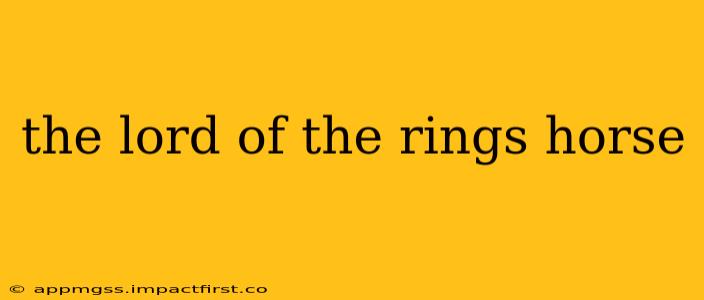J.R.R. Tolkien's The Lord of the Rings is renowned for its rich world-building, detailed characters, and epic scope. While the hobbits, elves, and dwarves often steal the spotlight, the horses of Middle-earth play a crucial, albeit sometimes understated, role in the story's events. This exploration delves into the various breeds, their significance, and the impact they had on the quest to destroy the One Ring.
What breeds of horses are mentioned or implied in The Lord of the Rings?
Tolkien doesn't explicitly name specific horse breeds in the same way he names elven clans or dwarf-holds. However, we can infer characteristics based on descriptions and their use. The horses depicted appear to be strong, sturdy breeds capable of carrying riders and enduring long journeys across varied terrain. They seem to combine elements of strength reminiscent of draft horses with the agility and stamina expected of warhorses or riding horses. Think of a breed possessing the power of a Clydesdale but the stamina of an Arabian. The specifics are left to the reader's imagination, allowing for a richer, more personal interpretation of the world. Their exact lineage is shrouded in the mists of Middle-earth's history, much like the history of many of the cultures.
What roles did horses play in the War of the Ring?
Horses served as vital mounts for both good and evil throughout the War of the Ring. For the Riders of Rohan, they were integral to their fighting style, their speed and strength key to their battlefield effectiveness. The Rohirrim were renowned horsemen, deeply connected to their steeds, showcasing a relationship that extended beyond mere transportation. Their horses were partners in battle, their loyalty and courage evident throughout their charges across the plains of Rohan. Conversely, the forces of Mordor also utilized horses, though perhaps less prominently, in their armies. These mounts contributed to the sheer scale of Sauron's forces, underscoring his military might.
Were there any particularly famous horses in the Lord of the Rings?
While specific horse names aren't prominently featured, the steeds of key characters, particularly the Rohirrim, implicitly hold significance. The unnamed horses ridden by Éomer, Théoden, and other Rohirrim warriors embody the spirit and strength of their riders. Their bravery on the fields of battle, their endurance in long rides, and their loyalty to their riders are implicitly demonstrated in their actions and their integral part in the battles, effectively making them almost characters themselves. These nameless steeds represent the collective strength and resilience of the Rohirrim people.
What is the symbolic significance of horses in the Lord of the Rings?
Horses in The Lord of the Rings serve as more than just modes of transportation. They symbolize freedom, strength, and the untamed aspects of nature. The Rohirrim's close bond with their horses reflects their connection to the land and their independent spirit. The horses' swiftness and power mirror the urgency of the quest and the determination of those who ride them. They represent the raw power and untamed spirit that stands in contrast to the mechanized, darker power of Mordor.
Did Tolkien draw inspiration from real-world horse breeds when creating the horses of Middle-earth?
While Tolkien doesn't explicitly cite specific real-world breeds as direct inspiration, it's plausible he drew inspiration from various historical accounts of horsemanship and warfare. The Rohirrim, with their cavalry tactics, evoke images of historical mounted warriors, suggesting a familiarity with the military use of horses throughout history. The overall depiction reflects a general understanding of horse breeds and their capabilities, likely informed by his knowledge of literature and history, rather than a specific breed acting as a direct template.
This exploration only scratches the surface of the rich tapestry of horses within Tolkien's legendarium. Their often-unspoken contributions to the narrative deepen the story’s resonance, reminding us that even the seemingly minor elements play vital roles in shaping the grand epic of The Lord of the Rings.
